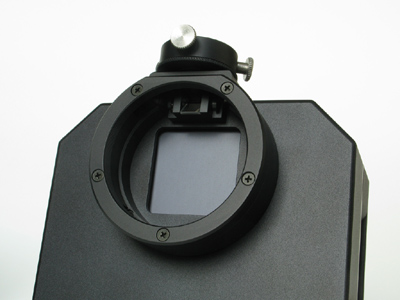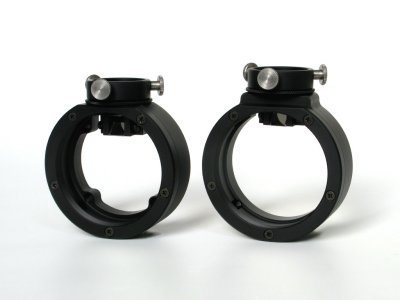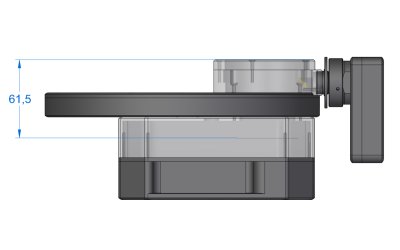
G4 camera head with OAG and M68 × 1 thread adapter Covering 24 × 36 mm detectors of G3 cameras or even 36 × 36 mm detectors of
G4 cameras requires good quality optics, large focusers and
field-flatteners or correctors. There is usually only a little space
within a field of view to which a mirror, reflecting light to the
guiding camera, can be placed. This is why there are two
modifications of large OAG adapters, one for G3 cameras and another
for G4 cameras.
- G3 variant places the mirror closer to the optical axis, because
the shorter side of G3 detectors never exceeds 24 mm and the elongated shape of G3 detectors allows
placing of the mirror well into the image circle, created by the
used optics.
- Situation is somewhat more complicated in the case of G4
cameras, because of the square shape of the used detectors.
Typically the well illuminated field of view has a diameter only
slightly exceeding 50 mm, very close to
the CCD diagonal dimension. Amount of light as well as image quality
rapidly degrade beyond this circle. The reflecting mirror is placed
close to the CCD detector edge to be as much inside the field of
view circle as possible, but on the other side as far from the
optical axis not to cover the detector when f/4 or faster optics is
used.

G3 OAG (left) places reflecting mirror closer to the
optical axis compared to G4 OAG (right) Common 2-inch barrel or M48 thread adapters are no option for both
G3 and G4 OAG adapters. They are simply too small and the OAG mirror
would be shielded from incoming light. So both G3 and G4 OAG types use
the same M68 × 1 threaded adapter, which
is enough even for G4 OAG. Also the back focal distance is the same
61.5 mm from the M68
adapter front.

G4 CCD camera with External Filter Wheel, OAG and
M68 × 1 thread adapter back focal
distance The mirror used to deflect light to guiding camera has 10 × 7 mm front
cross-section (mirror dimensions are 10 × 10 mm, but the
mirror is angled at 45 degrees). This is enough for guiding cameras
with very large 2/3" format detectors without any significant
vignetting (smallest detectors used in G0/G1 guiders is of 1/3"
format, but numerous guiding cameras use 1/4" or even smaller
chips).
G3-11000 camera with OAG (left) and the G3 OAG adapter in
detail (right) G4-16000 camera with OAG (left) and the G4 OAG adapter in
detail (right) |